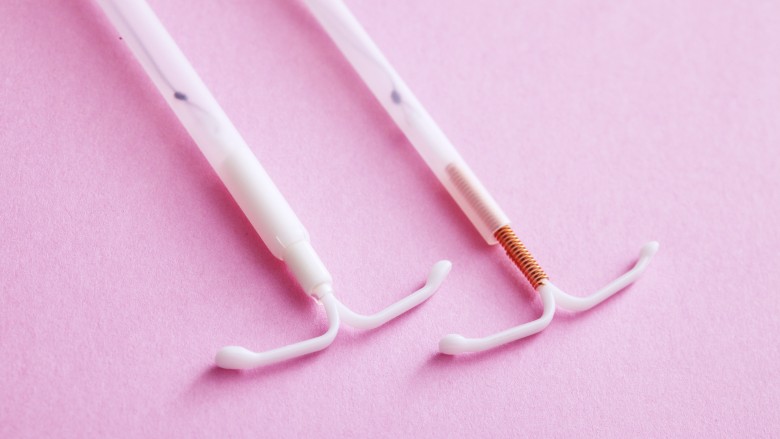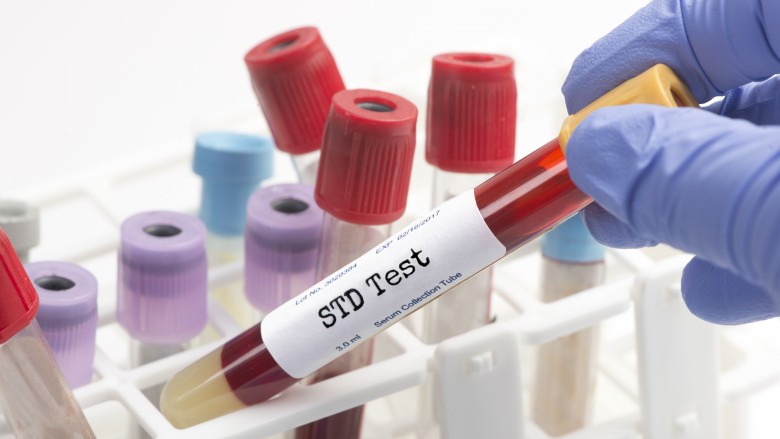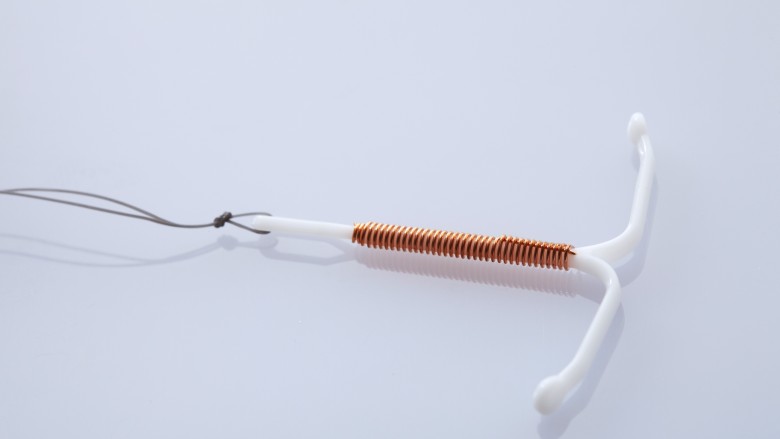What Really Happens When You Decide To Get An IUD
Intrauterine devices (IUDs) are one of the most effective forms of birth control available to women, particularly because they do not rely on compliance. That is, you don't have to remember to do anything in order for it to work. Doctors also recommend IUDs because they prevent pregnancy for between three and 12 years, making them cost-effective in the long run. Like virtually all forms of birth control, there are both risks and benefits to using an IUD and every woman's experience is different. I spoke to women who use or have used IUDs in the past to learn what the experience was like for them. Here's what really happens when you decide to get an IUD.
There are different types of IUDs
Before you get an IUD, you'll have to decide what kind you want. That's because there are five different IUDs that are currently approved by the Food and Drug Administration. While there are two main kinds (hormonal and nonhormonal), there is only one nonhormonal option (brand name ParaGard) while there are four options for the hormonal type: Liletta, Mirena, Skyla, and Kyleena, all of which use a type of progestin to prevent pregnancy.
You'll discuss your medical and menstrual history
When making the decision of whether to get a hormonal or nonhormonal IUD, you'll discuss your medical and menstrual history with your doctor. Hormonal birth control is not well tolerated by some women, while others are unable to manage the side effects of of the copper IUD. Your doctor will ask about your periods (are they heavy, do you get cramps, etc.) as well as your family history of certain disorders that may be impacted by the IUD.
You'll be able to ask questions
In addition to telling your doctor your medical and family history, you'll have an opportunity to ask questions. While there is a wealth of information online, having this conversation with your doctor can help dispel your fears. Some of the questions I heard from the women I talked to were how long the procedure would take, how much it would hurt, how long it would take to recover, how to know if something went wrong, what sorts of things can go wrong, safety of using the IUD while breastfeeding, and impact on future fertility.
Lei'La' Bryant from Brookings, Oregon told me that she freaked herself out by doing too much internet research beforehand, and that the practitioners who inserted her IUD at Planned Parenthood set her mind at ease. "They were calm and helpful and when I asked them how they would fix any of a multitude of possible things that could go wrong, they always had answers," she said.
You may receive exams and testing
While not all women have a pelvic exam prior to getting an IUD, many women opt to get an IUD after their annual visit, which includes a pelvic exam. For women who have recently had a baby, doctors often recommend an IUD at the six week postpartum check up. This was true for Justina Gilliam from the Boston Metro area, who despite not being great about consistently taking her birth control hadn't really considered an IUD until her doctor suggested it after she gave birth. "My doctor suggested it, actually, since I was at my 6 or 8 week postpartum check up visit," she said. "I guess that's a good time to make the leap because the uterus is still not completely back to its normal size but not extremely enlarged, either."
Whether or not you have a pelvic exam, your doctor will likely give you a pregnancy test and test you for sexually transmitted infections (STIs), though recent research suggests that regardless of STI screening prior to getting an IUD, the risk of Pelvic Inflammatory Disease is low.
There are things you can do to prepare
While prior pregnancy is not a requirement for getting an IUD, many times the insertion of an IUD is easier for a woman who has already had children. This is because her uterus has been stretched and her cervix dilated in the past. For women who haven't had children, like Megan Hill of Rising Fawn, Georgia, your doctor may give you medication to take the night before your IUD insertion to help your cervix dilate and soften, making the insertion a bit easier. "I was nervous about the insertion because I have never had children so my uterus has never been dilated," Hill told me. "They gave me a medication to take the night before and the morning of to help soften [my cervix]." The medication paid off. "[The doctor] told me that my uterus had softened and moved beautifully and that was the easiest insertion she has ever done," Hill said.
Your uterus might be measured
If you haven't had children, your doctor may measure your uterus to ensure there is enough space for the IUD to be placed and function properly. This also helps ensure that your uterine wall will not be punctured when the IUD is placed. To do this, the doctor will use a metal instrument, called a sound, inserted through your cervix. Depending on the size of the sound used, this may also begin to dilate your cervix, so your doctor may warn that there will be some cramping or pain.
The insertion may be a breeze
After the uterus is measured, the IUD will be inserted in the uterine cavity through the cervix. For some women, the insertion of the IUD feels like a pinch followed by pressure or a cramp with only brief discomfort. For many this is especially true if the insertion is done at a postpartum checkup.
Deidre Smith from Somerville, Massachusetts read a lot about the pain before her insertion and built it up in her mind. "The actual insertion was painful, but very quick," she said. "It essentially felt like the most intense period cramp I've ever had, but it was definitely bearable and not nearly as bad as I expected." For some women the pain is even less — almost nonexistent. Yokasta Schneider from St. Charles, Missouri rated the pain at a two on a one to 10 scale. "The insertion felt like pinching," she said. "[The pain] was gone by the time the process was over."
Or the insertion may be quite painful
While insertion is very easy for some people, it can be quite painful for others and researchers are still trying to understand why. One factor may be history of childbirth (more pain for those who have never had children and have a smaller cervix or uterus). This was the case for Kristi Fenstermacher from Seattle. "I never really had bad period cramps, so insertion seemed pretty bad compared to what I was used to — I would put it at like eight," she said. "I agreed to let a student observe the doctor who inserted my first IUD, and she said I had the smallest cervix she'd ever seen."
Some pain may persist even longer, like for Caitlin Rys who had a history of low back soreness right before the onset of her period and who had low back pain for two weeks after her IUD was inserted, despite the fact that her insertion went smoothly.
Sometimes the pain is due to an inexperienced doctor
Kara Dockery from Florida said that her IUD insertion was the worst gynecologist experience ever. "The doctor told me it would be painless; on a scale of one to 10, it was easily an 11." she said. The doctor gave me no warning whatsoever. He snipped (with scissors) my cervix to make the opening bigger and then shoved the IUD into place," Dockery told me. "I literally screamed in pain right there in the doctor's office [then] went home crying with the instructions to 'just take Motrin.'" Unfortunately it only went downhill from there for Dockery. "I had a lot of pain that lasted from the day of insertion up until I got it removed eight months later because it became unbearable," she said. "It turns out that in the doctor's haste to insert it, he bent or broke one of the wings of the IUD and it ended up embedding itself in my uterine wall."
You could pass out
In some cases, both when the procedure is painful and when it isn't, a woman may briefly blackout or lose consciousness. Karissa K. who is from Pennsylvania but got her IUD prior to moving abroad to China recently, wasn't prepared for this to happen. "The insertion itself wasn't bad, but when I walked out to make my follow-up appointment I told the nurse I didn't feel well," she told me. "I sat down and the next thing I remember was being slumped over in a chair in the waiting room with nurses in front of me asking me how I was."
Karissa said it took about an hour for her to feel better and, because she drove herself there, she took the full hour and snacks the office provided her to "perk up" enough to drive home. "The nurse said that sometimes the insertion taps a vaginal nerve, and people can pass out. I hadn't been warned and I have a history of passing out, so I was a little angry because I would've taken precautions, had I known," she said. "And women should know about the possibility of losing consciousness. It happens to me more often when I get blood drawn, but this frightened me because I might have made it to my car to drive myself home."
You'll need to check for it
The IUD has strings at the bottom, which extend beyond the cervix. Although stiff at first, the strings soften over time. These strings are important because they let you know that your IUD is still in place, which means you'll want to check for the strings occasionally. If you cannot feel the strings of your IUD, you may have expelled the device or it may have shifted placement. If this happens, make an appointment with your doctor to check for the IUD to ensure it will still work properly.
indication that something isn't right with the IUD placement is pain. Natasha Boatwright had her Mirena removed because of constant pain and discovered it hadn't been placed properly to begin with. "When my period started it was non stop bleeding for 18 days and my midwife reassured me it would stop (which it did), but I had a period twice a month for nine months," Boatwright told me. "I constantly had excruciating pain in my lower abdomen that just wouldn't go away. After nine months of dealing with never ending periods and constant pain I made my fourth appointment, this time to have the Mirena taken out." When the midwife she was seeing went to remove the IUD, she discovered it was only halfway in Boatwright's uterus (sitting low and partially inside her cervix). "[The midwife] said it was not placed right in the first place," Boatwright told me. "That was the reason for the constant bleeding and the constant pain: my body had been trying to push this foreign object out."
Your periods may get lighter or disappear altogether
Depending on the type of IUD you choose, your periods may change. Many women using Mirena or other forms of hormonal birth control end up losing their period altogether. In fact, for some this is one of the main selling points over other forms of birth control. It's important to note though that even with the Mirena, your periods may be heavy before they start to get lighter or disappear.
Former Mirena user Cortney Erxleben told me that she chose the Mirena over the copper IUD because she wanted to avoid the heavy periods, but almost had the Mirena removed when her period were still heavy at first. "For the first two months I bled constantly," she said. "It was a light flow, but I was still very frustrated and debated getting the device removed." Ultimately Erxleben's doctor urged her to give it a bit longer and after the third month she stopped having periods altogether. She only got the Mirena removed when she and her husband decided to start trying to conceive again.
Or they may get very heavy
One of the most commonly reported side effects of the copper IUD is an increased period flow with cramping. When I spoke to Juliette I. from Massachusetts, she told me this is one of the reasons she had her ParaGard removed. "With the copper IUD my periods changed drastically," she told me. "I do remember learning that the copper IUD can make periods heavier and cramps worse, but I guess because I had been taking hormonal [birth control] for so long, my periods were pretty manageable and I thought I could handle it. I was wrong."
Juliette told me her period were worse than anything she had ever experienced, both extremely heavy and painful. "I remember one night I went to sleep with a super plus tampon and overnight pad on and woke up with menstrual blood soaked through both, as well as my pajama pants and sheets," she told me, adding that she also had horribly painful cramps that radiated down her legs. This pain was so intense that she was very worried the IUD had perforated her uterus. "After two or three of these periods, I decided to have the IUD removed," she said. "I know that it's supposed to get better over time, but I couldn't bear it."
Some side effects are more serious than others
Changes to your period aren't the only possible side effects of the IUD. For hormonal IUDs, many of the side effects are similar to other progestin-only methods of birth control. On rare occasions, your uterus may be perforated during the insertion of the IUD. This is essentially when the doctor inserting the IUD pushes it too far and creates a hole in the uterus. This can cause the IUD to become embedded. In addition to perforated uterus, which could require hospitalization, serious side effects can develop over time. While both the copper and hormonal IUDs have a lower risk of blood clots, they can still happen so you shouldn't ignore the signs.
Safari Charles from Maryland, better known online as Fit Momma, shared her scary experience with me. After developing pelvic pain and abnormal bleeding with her second Mirena, she decided to have it removed, but she wasn't out of the woods. "Shortly after removing the Mirena I had a pulmonary embolism and could have died," she told me. "I was misdiagnosed at a emergency care facility and rapidly declined. I was admitted into the hospital and then put on blood thinners for six months." Once doctors realized what had happened, a specialist ran tests and concluded the pulmonary embolism was a result of the IUD. "Needless to say, I am currently birth control free and have zero plans of using any form of birth control ever again," she said. "I'll take my chances at another birth over my death." While this type of experience is extremely rare, this is an important reminder to listen to your symptoms and get a second opinion if something seems wrong, no matter how unlikely it is.
There may be other benefits too
While the side effects can range from annoying to scary, the IUD can come with benefits in addition to long-term birth control and (depending on the type of IUD), little to no period. Jane Theriault initially used the copper IUD, but switched to Mirena when the benefits of the hormones outweighed the migraines they had caused her in the past. "When I was 25, I finally got diagnosed with chocolate cysts and endometriosis and had to switch back to hormones to control the symptoms," she told me. Not only is the hormonal IUD recommended by the National Institute of Health as a treatment for endometriosis, there are other non-contraceptive uses like the treatment of painful periods, anemia associated with heavy menstrual bleeding, and hormone replacement therapy.
Your partner may feel it during sex
Remember those strings we talked about? Sometimes your partner may be able to feel them during sex, especially early on when the strings are still a bit stiff. While your doctor can cut them shorter, it's important to know that this in itself can lead to difficulties later on. Audrey Orozco from Texas knows this first hand. "My doctor cut my strings too short with my first IUD after I had requested him to cut them shorter," she said. "When they inserted my second ID they couldn't find the strings so they had to open my cervix a little bit." Orozco told me this made the process a lot more painful. "Moral of the story give your body time to adjust into place, soften up the IUD naturally and don't get influenced by your partner to make decisions based purely on their idea of pleasure," she said. "It all settles in and I've never heard a complaint with my current partner once."
You'll eventually need another one
IUDs don't last forever, which means their ability to prevent pregnancy has an expiration. While ParaGard lasts for up to 12 years, Mirena prevents pregnancy for up to six years, Kyleena works for up to five years, and Skyla and Liletta work for up to three years. If you want to continue using an IUD to prevent pregnancy, this means you'll need to have the old one removed and a new one put in by your doctor or gynecologist. While some women said the second IUD insertion experience was pretty similar to the first, others said it was notably different. Sarah Norris had an incredibly painful first experience, but her second and third IUDs weren't bad at all. "After the initial [IUD] you know more what to expect," she said. "With the other two it was fine."
It can be removed if you want to get pregnant
When the strings of the IUD are still visible, your doctor is able to grasp them and easily pull your IUD out (the "arms" fold up and it slides out through your cervix). In cases where the strings have gone missing, your doctor will use an ultrasound to confirm the IUD is in place and hasn't been expelled, then he or she may need to use an IUD removal device like a cylindrical brush or an IUD hook to locate the device. In most cases, one of these tools will quickly grasp onto the missing strings of your IUD allowing it to be removed, but occasionally an extra step must be taken.
Sometimes it must be surgically removed
In rare cases, using the cylindrical brush and IUD hook are ineffective. This may be because the pain is too intense for the patient and/or because with several attempts the strings are still not found (despite the IUD being visible on ultrasound). If your IUD has embedded into the wall of your uterus or migrated outside of the uterus, surgical removal may be necessary. For slightly embedded or difficult-to-retrieve IUDs, your doctor may perform a hysteroscopy (which does not require an incision) to look inside your uterus and retrieve the IUD. This can be done either under local or general anesthesia and is an outpatient procedure. If your IUD is deeply embedded in your uterus or has migrated outside your uterus, your doctor may use minilaparotomy or laparoscopy to remove it, both of which require a small incision.
For many women the benefits are worth the risks
While there are potential side effects to the IUD and the insertion process can be painful, many women feel it's worth it, as evidenced by the fact that the rates of long acting reversible contraceptives like the IUD (and the implant) have been rapidly increasing in the last several years after a holding steady from 1988-2002. Of the women using a long active reversible contraceptive in 2012, 83 percent used an IUD.
Selena Jones told me she had tried every form of birth control imaginable and available by the time she was 24. "I am allergic to latex, and for the life of me, I cannot remember to take the pill," she said adding that she has terrible periods so didn't like any of the options that allowed her to continue to have one. After her second child, she got the IUD again. "I desperately tried to get the IUD put in before I started my first period after having the baby, but insurance didn't cooperate," she said, but it was worth the wait. "Getting a second IUD was a no-brainer."
Make sure it's the right decision for you
While the use of IUDs is increasing and more doctors are recommending them, the decision is still one that is entirely up to you. While many of the women I spoke with couldn't be happier with their IUD, some regretted the decision to ever get one. Emily Cervone's doctor suggested she switch to an IUD for a long time before she made the decision and said that her doctor wanted her to come to the decision on her own and never pressured her. "I do not for one second regret my decision, but before you get one, truly look into whether it's the direction you want to go in," Cervone said. "I do think you need to be attuned to your body — especially small changes otherwise you may overlook complications." An honest, frank discussion with your doctor might help you decide if an IUD is right for you. If it is, now you know what to expect.






















